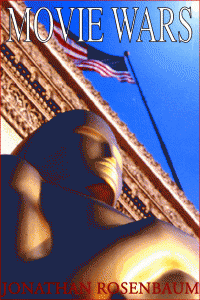From Moving Image Source (www.movingimagesource.us), posted September 22, 2009. Also reprinted in my collection Goodbye Cinema, Hello Cinephilia. — J.R.

Following James Agee: Film Writing and Selected Journalism (2005), and American Movie Critics (2006), Farber on Film: The Complete Film Writings of Manny Farber is the Library of America’s third and so far most ambitious effort to canonize American film criticism — a daunting task that’s been lined at every stage with booby traps, at least if one considers the degree to which film criticism might be regarded as one of the most ephemeral of literary genres. And this is certainly the volume that adds the most to what has previously been available; by rough estimate, it easily triples the amount of film criticism by Manny Farber that we have between book covers.
As Karl Marx once pointed out, quantity changes quality, but this doesn’t entail any lessening of Farber’s importance. I would even argue that both the nature and evolution of his taste and writing over 30-odd years, before he gave up criticism to concentrate on his painting, still make him the most remarkable figure American film criticism has ever had.
Bringing a painter’s eye to film criticism and couching even his most serious observations in a snappy, slangy prose, Farber was the first American in his profession to write perceptively about the personal styles of directors and actors without any consumerist agendas or academic demonstrations. Read more
The first part (roughly the first half) of Chapter One of my most popular book, Movie Wars: How Hollywood and the Media Limit What Films We Can See (2000). The second half will be posted tomorrow; the illustration below is from the now out-of-print English edition. — J.R.
Is the Cinema Really Dead?

[The] early nineties have not been as encouraging as the early seventies.. . . It is not as easy now to believe in the medium’s vitality or its readiness for great challenges. So many of the noble figures of film history aredead now, and who can be confident that they are being replaced? . . . .The author sees fewer films now. He would as soon go for a walk, look at paintings, or take in a ball game. [1994]
It has become harder, this past year, to go back in the dark with hope or purpose. The place where “magic” is supposed to occur has seemed a lifeless pit of torn velour, garish anonymity, and floors sticky from spilled sodas. Forlornness hangs in the air like damp; things are so desolate, you could set today’s version of Waiting for Godot in the stale, archaic sadness of a movie theater. Read more
My column for the Summer 2016 issue of Cinema Scope. — J.R.


J.P. Sniadecki’s feature-length The Iron Ministry (2014), available on DVD from Icarus Films, is by far the best non-Chinese documentary I’ve seen about contemporary mainland China. (Just for the record, the best Chinese documentary on the same general subject that I’ve seen is Yu-Shen Su’s far more unorthodox—and woefully still unavailable — 2012 Man Made Place; a couple of snippets are available on YouTube and Vimeo.) Filmed over three years on Chinese trains, it’s full of revelatory moments, and not only in its surprisingly outspoken interviews: the non-narrative stretches, which compare quite favourably with the more abstract portions of Lucien Castaing-Taylor and Véréna Paravel’s Leviathan (2012), are pretty stunning as well. Skip this one at your peril.

Second Run’s very first Blu-ray — Pedro Costa’s Horse Money (2015) — is gorgeously transferred, and has splendid extras: Costa’s 2010 short film O nosso homem, essays by Jonathan Romney and Chris Fujiwara, an introduction to Horse Money’s introduction by Thom Andersen, and Laura Mulvey’s conversation with Costa at London’s ICA. The extras on Criterion’s Blu-ray of Jean-Luc Godard’s Band of Outsiders (1964) are too numerous to mention here, but suffice it to say that just about every intertextual reference in this cherished object are teased out in one way or another. Read more





